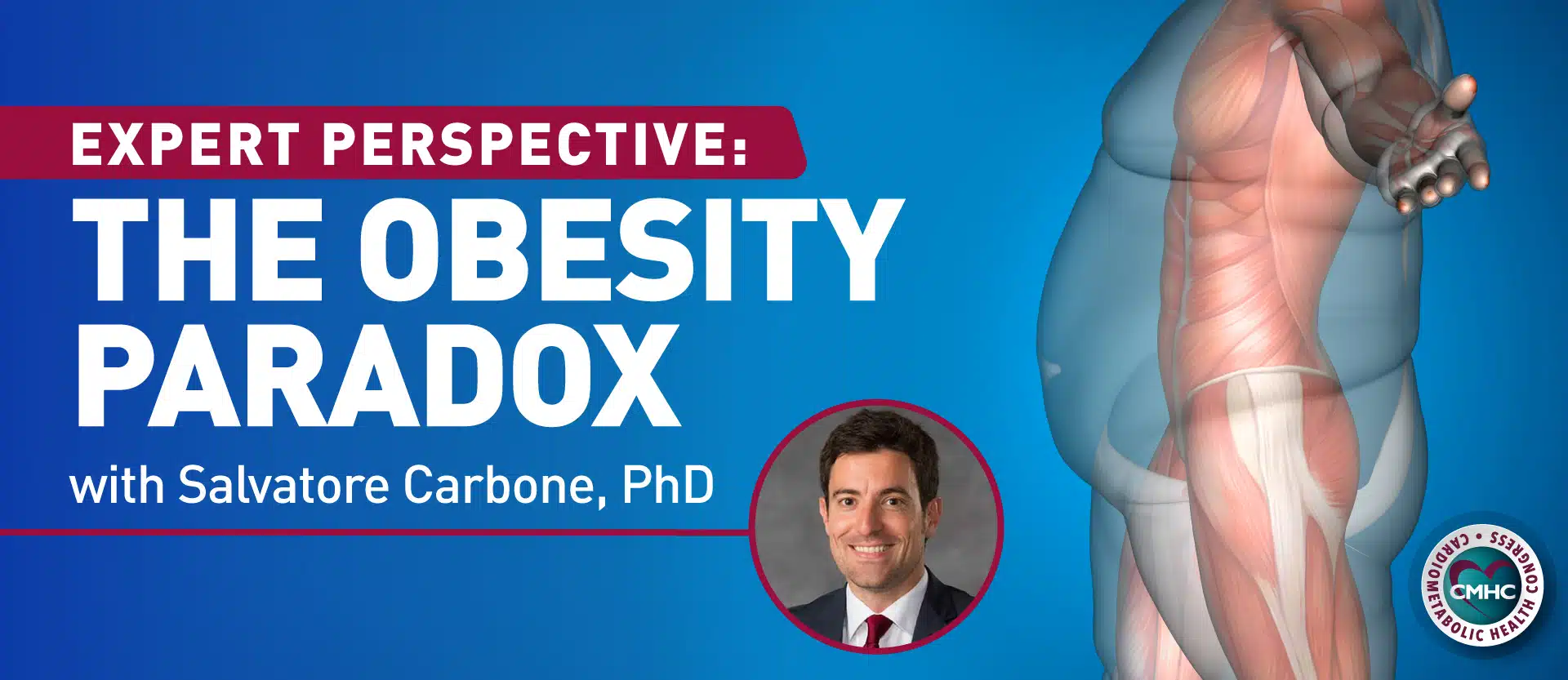
Can you please explain the concept of an obesity paradox?
Salvatore Carbone, PhD: First, I’d like to point out that obesity is a major risk factor for cardiometabolic disease. There are significant data that show that if you have obesity, you have a high risk of developing coronary heart disease, heart failure, type 2 diabetes (T2D) or risk factors such as hypertension and dyslipidemia. [1]
Several reports from epidemiologic studies, however, show that once you have established cardiovascular disease, particularly coronary heart disease or heart failure, obesity can exert some degree of protection. [2, 3] This association is more pronounced for those with class I obesity, which is a body mass index (BMI) between 30-35 kg/m2. These individuals tend to have a better prognosis when compared to both individuals with normal weight (BMI of 18.5 to 25 kg/m2) and underweight (BMI less than 18.5 kg/m2). This benefit is less pronounced in patients with class II obesity (BMI 35 to 39.9 kg/m2) or severe obesity (BMI greater than 40 kg/m2). Early studies demonstrate that in ambulatory patients with advanced heart failure, overweight and obesity were not risk factors for increased mortality, but it was associated with a trend towards improved survival compared to underweight or normal weight individuals. [4]
More recently, at least at the epidemiologic level, the obesity paradox has been confirmed in both heart failure with reduced ejection fraction (HFrEF) and heart failure with preserved ejection fraction (HFpEF), but also in those with coronary heart disease. [5, 6] So, it seems that once cardiovascular disease is present, then obesity may offer some degree of protection.
Is the obesity paradox a real phenomenon?
Dr. Carbone: I believe that the obesity paradox is a real phenomenon, but we still don’t clearly understand the underlying mechanisms responsible for it, nor do we have data from large multicenter randomized controlled trials looking at targeting obesity in the setting of heart failure or other established cardiovascular disease, so we can’t say this with certainty. One hypothesis we have proposed as a group is that patients with obesity in addition to having excess body fat, typically also have excess lean mass, which is a surrogate for skeletal muscle mass. [8] And we know that high lean mass is associated with improved prognosis in some cardiovascular conditions, including heart failure.
So, it is plausible to think that patients with obesity may do better because they have that excess lean mass. We recently published a review article in Current Problems in Cardiology discussing the role of lean mass and different body composition phenotypes (sarcopenia, sarcopenic obesity and cachexia) in determining cardiorespiratory fitness and overall prognosis in heart failure, where we make a strong distinction between the use of BMI and body composition compartments such as lean mass. [9] For example, heart failure patients with excess body fat but a low amount of lean mass (also called sarcopenic obesity) are the ones who actually do worse and have the most impaired cardiorespiratory fitness, even if they have class I obesity, so it is important to make that distinction.
Could some of the obesity paradox be attributed to relying too heavily on BMI to evaluate obesity?
Dr. Carbone: At a population level, BMI remains a very good marker of adiposity and it still remains a strong predictor for the development of cardiometabolic disease.10 However, in some conditions BMI is just not enough. Patients with heart failure for instance, have continuous changes in fluid status, which is unfortunately part of the pathophysiology of the disease which ultimately leads to increased risk for hospitalizations, and using BMI may often misclassify a patient as overweight or obese. Those are the setting in which I strongly believe we should really start looking at body composition, quality of the weight, how much of weight is fat, how much is fluid, and how much is muscle mass, rather than just focusing on total body weight and calculated BMI.
To do this, however, you need some relatively sophisticated tools that not everybody has available in their practice, including devices to measure body composition, like bioelectrical impedance analysis (BIA), which is frequently being used in research and more recently also in clinical practice. Other tools involve dual-energy X-ray absorptiometry (DEXA), which is mostly used in research to estimate total body composition and segmental body composition (i.e., appendicular lean mass), and more sophisticated tools like magnetic resonance imaging (MRI) or computed tomography (CT) scans.
What are some other ways to asses adiposity?
Dr. Carbone: There are some very cheap and practical ways to assess adiposity, particularly its distribution, in addition to BMI. For example, in our clinical practice here in Richmond, we always do an assessment of waist circumference in addition to BMI and BIA when available. Measuring waist circumference is very easy to do and is a good assessment of visceral adiposity, which is considered to be a strong cardiometabolic risk factor. So, in addition to just keeping track of changes in BMI, we also always keep track of the changes in waist circumference. For example, if you have an individual with a BMI of 23 kg/m2 and without any cardiovascular disease, but with a waist circumference of 104 cm (cut-off for men is <102 cm and for women <88cm), that individual would be considered to have an increased cardiometabolic risk despite having a normal BMI and no other apparent red flags. Overall, BMI is a decent tool, but we can do better, and there are definitely other practical tools that we can use.
You research physical activity and cardiovascular health. What levels of exercise intensity or duration are beneficial?
Dr. Carbone: The new physical activity guidelines were published in 2018, an update after 10 years from the prior guidelines. [11] They recommend that the ideal amount of physical activity for adults is 150 to 300 minutes a week of moderate-intensity, or 75 to 150 minutes a week of vigorous-intensity aerobic physical activity per week, or a combination of both.
A good way to practically think about this to define moderate-intensity is an activity that involves fast walking (a pace of 3 to 4 mph), which is what we typically recommend to our patients. In addition to aerobic physical activity, the recommendation is also to add some kind of strength exercise two days a week, and although this seems to be a relatively easy goal to meet, it is very scary to think that only 30% of people actually meet the physical activity guidelines. Compared to the 2008 guidelines, where only exercises or activities that last at least 10 minutes could count towards the 150 minute/week goal, in the 2018 guidelines, any kind of moderate to vigorous physical activity can count toward the weekly goal, regardless of duration. This is important because now we can consider any kind of physical activity we do throughout the day to count towards the goal.
The levels of physical activity recommended in the guidelines have been associated with significant improvements in cardiometabolic health, including reduction in cardiovascular disease, overall mortality, improved mental health, sleep quality, as well as prevention of weight gain, obesity and T2D. So, we should definitely do a better job in promoting physical activity and make sure that our patients actually meet these guidelines. [12]
Is a patient who exercises regularly but spends the rest of the day sedentary still at higher risk?
Dr. Carbone: A study recently published in the Journal of the American College of Cardiology looked at the effect of physical activity and sedentary behaviors in a very large number of patients,13 and we have reviewed this topic in a recent review published on Circulation Research. [14] What they found is that if you meet the guideline recommendations for physical activity, unless you are sitting for more than 8 hours a day, the sedentary behavior does not affect your cardiovascular risk, suggesting that physical activity is somewhat counteracting the damages induced by sedentary behavior.
If you are not physically active, however, or doing less than the recommended physical activity levels, then the amount of sedentary behavior really matters, in fact, the more you sit the higher is your risk to develop cardiovascular disease in a dose-dependent manner. Thus, especially in individuals with low physical activity, sedentary behavior should be addressed and highly discouraged as a potential approach to improve cardiovascular health. Another important part that the study addressed is that replacing 1 hour of sitting with 1 hour of moderate-to-vigorous physical activity can reduce cardiovascular disease risk by 20% with this risk being reduced by over 60% when replaced with vigorous physical activity.
Another interesting study recently published in JAMA Internal Medicine looked at the number of steps associated with lower mortality rates in a large population of older women. [15] The authors found that women who walked 4400 steps/day had a lower mortality risk compared to those who walked 2,700 steps/ day over a follow-up period of 4.3 years, with no mortality benefit in women that walked more than 7500 steps/day. We tend to recommend to walk at least 10,000 steps a day in clinical practice, but in this study, and at least in the investigated population, they found that when you go above 7500 steps there wasn’t really a reduction of all-cause mortality.
The good news is that even if you sit for very long or do not walk 10,000 steps a day, if you increase the amount of daily physical activity, including the number of daily steps, you can still significantly reduce your cardiovascular risk. This is something that all clinical providers should address in their visits with patients, in fact, asking questions to trying to quantify daily physical activity and sedentary behaviors and ultimately trying to address them, could result in improved overall cardiovascular and metabolic health.
To what extent are lifestyle factors, like physical activity and nutrition, addressed during a routine visit?
Dr. Carbone: Frequently, clinical providers, including primary care physicians, cardiologists, endocrinologists, physician assistants, nurse practitioners and pharmacists tend to dedicate very little time to addressing lifestyle factors. But with a myriad of issues to think about, including optimizing medications, addressing patient compliance, potential recent admissions, and more, clinicians are extremely busy and simply do not have time.
It is for this reason that the 2019 ACC/ AHA guidelines for primary CVD prevention encourage referrals of patients to clinicians and professionals that specialize in lifestyle medicine and can adequately address nutrition and physical activity, such as dietitians, whose role to improve cardiovascular health is too often underestimated. [16] I still think, however, that in the absence of a nutrition expert, providers can do a better job in doing a brief lifestyle assessment, for instance, asking some crucial questions about daily physical activity or diet, which could make a difference in our patients’ health. Definitely, increasing the number of hours dedicated to nutrition during medical school would help achieve such a goal.
What is the role of sodium-glucose co-transporter (SGLT)-2 inhibitors or glucagon-like peptide-1 (GLP-1) receptor agonists in addressing CVD risk?
I think we live in a very exciting time right now for those who work in diabetes and cardiovascular disease. We have to consider that until a few years ago, all we were doing in terms of treating diabetes was to improve glycemic control, which improves microvascular complications, like neuropathy, nephropathy, and retinopathy, as data from the UKPDS study suggested. [17] Glycemic improvement alone, however, has not been associated with improved risk of macrovascular diabetes complications, such as myocardial infarction, stroke and heart failure.
This was a huge gap, because most patients with T2DM die from cardiovascular disease, and until recently, we had no means of preventing adverse cardiovascular events in these patients. Cardiovascular outcomes trials with SGLT-2 inhibitors have shown a strong effect in preventing major cardiovascular events (i.e., empagliflozin18 and canagliflozin19), and particularly heart failure and renal events in patients with T2D (i.e., empagliflozin, canagliflozin and dapagliflozin20), even in patients with T2D-related nephropathy (i.e., canagliflozin21) that affects a large portion of patients with T2D, further increasing their cardiovascular risk. Furthermore, these effects seem to be independent of glycemic control, although we still don’t fully understand the mechanisms involved. Due to these remarkable results, SGLT-2 inhibitors are being evaluated in clinical trials for heart failure patients, even without T2D.
GLP-1 RAs such as liraglutide [22], semaglutide [23] and albiglutide [24] have shown a strong signal in preventing atherosclerotic cardiovascular disease as well as renal events in patients with T2D, although not all agents in this class have shown uniformity in this aspect. Based on these results, updated diabetes guidelines recommend that in T2D patients with atherosclerotic cardiovascular disease, we should use GLP-1 RAs, and in T2D patients with heart failure or chronic kidney disease, we should use an SGLT-2 inhibitor after first-line therapy with lifestyle and metformin [25].
The type of agent that we ultimately choose to address cardiovascular risk in patients with T2D also depends on patient characteristics and comorbidities; for example, most GLP-1 RAs have very favorable metabolic effects by promoting significant weight loss, which is clearly desirable in obesity, while SGLT-2 inhibitors exert a much stronger effects on blood pressure. So, if a patient is concerned about their weight or blood pressure, treatment needs to be individualized accordingly. [26] Finally, when one of these agents is not sufficient to achieve glycemic goals, a combination of GLP1-RAs and SGLT-2 inhibitors should also be considered.
- Ortega, Francisco B., Carl J. Lavie, and Steven N. Blair. “Obesity and cardiovascular disease.” Circulation Research 118.11 (2016): 1752-1770.
- Carbone, Salvatore, et al. “Obesity paradox in cardiovascular disease: where do we stand?.” Vascular Health and Risk Management 15 (2019): 89 – 100.
- Carbone, Salvatore, Carl J. Lavie, and Ross Arena. “Obesity and heart failure: focus on the obesity paradox.” Mayo Clinic Proceedings 92.2 (2017): 266 – 279.
- Horwich, Tamara B., et al. “The relationship between obesity and mortality in patients with heart failure.” Journal of the American College of Cardiology 38.3 (2001): 789-795.
- Padwal, R., et al. “The obesity paradox in heart failure patients with preserved versus reduced ejection fraction: a meta-analysis of individual patient data.” International Journal of Obesity 38.8 (2014): 1110 – 1114.
- Romero-Corral, Abel, et al. “Association of bodyweight with total mortality and with cardiovascular events in coronary artery disease: a systematic review of cohort studies.” The Lancet 368.9536 CLINICAL CONVERSATIONS 26 www.cardiometabolichealth.org (2006): 666-6 n b vg78.
- Lavie, Carl J., et al. “Healthy weight and obesity prevention: JACC Health Promotion Series.” Journal of the American College of Cardiology 72.13 (2018): 1506 – 1531.
- Carbone, Salvatore, et al. “Obesity, body composition and cardiorespiratory fitness in heart failure with preserved ejection fraction.” Future Cardiology 13.5 (2017): 451-463.
- Carbone, Salvatore, et al. “Lean mass abnormalities in heart failure: the role of sarcopenia, sarcopenic obesity and cachexia.” Current Problems in Cardiology (2019).
- Ortega, Francisco B., et al. “Body mass index, the most widely used but also widely criticized index: would a criterion standard measure of total body fat be a better predictor of cardiovascular disease mortality?.” Mayo Clinic Proceedings. 91.4 (2016): 443 – 455.
- Piercy, Katrina L., and Richard P. Troiano. “Physical activity guidelines for Americans from the US Department of Health and Human Services: cardiovascular benefits and recommendations.” Circulation: Cardiovascular Quality and Outcomes 11.11 (2018): e005263, also available at https:// health.gov/paguidelines/second-edition/pdf/ Physical_Activity_Guidelines_2nd_edition.pdf
- Fletcher, Gerald F., et al. “Promoting physical activity and exercise: JACC health promotion series.” Journal of the American College of Cardiology 72.14 (2018): 1622-1639.
- Stamatakis, Emmanuel, et al. “Sitting time, physical activity, and risk of mortality in adults.” Journal of the American College of Cardiology 73.16 (2019): 2062-2072.
- Lavie, Carl J., et al. “Sedentary behavior, exercise, and cardiovascular health.” Circulation Research 124.5 (2019): 799-815.
- Lee, I-Min, et al. “Association of Step Volume and Intensity With All-Cause Mortality in Older Women.” JAMA Internal Medicine (2019).
- Arnett, Donna K., et al. “2019 ACC/AHA guideline on the primary prevention of cardiovascular disease.” Journal of the American College of Cardiology (2019): 26029.
- UK Prospective Diabetes Study (UKPDS) Group. “Intensive blood-glucose control with sulphonylureas or insulin compared with conventional treatment and risk of complications in patients with type 2 diabetes (UKPDS 33).” The Lancet 352.9131 (1998): 837-853.
- Zinman, Bernard, et al. “Empagliflozin, cardiovascular outcomes, and mortality in type 2 diabetes.” New England Journal of Medicine 373.22 (2015): 2117-2128.
- Neal, Bruce, et al. “Canagliflozin and cardiovascular and renal events in type 2 diabetes.” New England Journal of Medicine 377.7 (2017): 644-657.
- Wiviott, Stephen D., et al. “Dapagliflozin and cardiovascular outcomes in type 2 diabetes.” New England Journal of Medicine 380.4 (2019): 347- 357.
- Perkovic, Vlado, et al. “Canagliflozin and renal outcomes in type 2 diabetes and nephropathy.” New England Journal of Medicine 380.24 (2019): 2295-2306.
- Marso, Steven P., et al. “Liraglutide and cardiovascular outcomes in type 2 diabetes.” New England Journal of Medicine 375.4 (2016): 311-322.
- Marso, Steven P., et al. “Semaglutide and cardiovascular outcomes in patients with type 2 diabetes.” New England Journal of Medicine 375.19 (2016): 1834-1844.
- Hernandez, Adrian F., et al. “Albiglutide and cardiovascular outcomes in patients with type 2 diabetes and cardiovascular disease (Harmony Outcomes): a double-blind, randomised placebo-controlled trial.” The Lancet 392.10157 (2018): 1519-1529.
- American Diabetes Association. “9. Pharmacologic approaches to glycemic treatment: standards of medical care in diabetes—2019.” Diabetes Care 42.Supplement 1 (2019): S90-S102.
- Carbone, Salvatore, et al. “Glucose-lowering therapies for cardiovascular risk reduction in type 2 diabetes mellitus: State-of-the-Art Review.” Mayo Clinic Proceedings 93.18 (2018): 1629 – 1647.









